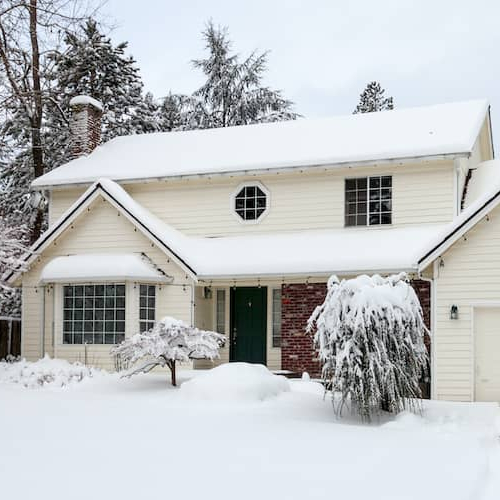What is a conventional loan?
Sep 10, 2024
•6-minute read
As of November 16, 2025, both Fannie Mae and Freddie Mac no longer have a minimum credit score threshold in their conventional loan eligibility guidelines. Loan approval will instead be based on an evaluation of overall credit risk factors.
A conventional mortgage loan is a type of loan that is not directly insured by a government program. Conventional mortgages are available with several different term options with most people choosing between 15-year and 30-year terms.
They’re quite popular — U.S. Census Bureau data from 2023 shows that 73% of home buyers used conventional financing to purchase single-family homes.
But before choosing this loan type, make sure you meet common lender requirements and review the pros and cons.
How a conventional loan works
Conventional loans work like most mortgages:
- A borrower applies to a lender for a specific loan amount.
- The lender then reviews the borrower's qualifications and approves the loan
- After the loan is finalized and the borrower closes on their new home, they’ll repay the loan in monthly installments.
Most conventional loans are also “conforming” loans (versus non-conforming), which simply means that they meet the requirements for Fannie Mae or Freddie Mac. Both are government-sponsored enterprises that purchase mortgages from lenders and sell them to investors.
Because there are several different sets of guidelines that fall under the umbrella of “conventional loans,” there’s no single set of requirements for borrowers.
Conventional loan requirements
As with any type of mortgage loan, you’ll need to meet certain qualification requirements if you want to buy a home with a conventional loan. Let’s take a look at what you’ll generally need to qualify for this type of home loan.
- Down payment: It’s possible for first-time home buyers to get a conventional mortgage with a down payment as low as 3%. However, down payment requirements can vary. A mortgage calculator can help you figure out how your down payment amount will affect your future monthly payments.
- Private mortgage insurance: You’ll be required to pay for private mortgage insurance (PMI) if you put down less than 20% on a conventional loan. PMI protects mortgage investors in case a borrower defaults on the loan. The cost for PMI may vary based on your loan type, credit score and down payment.
- Conventional loan limits: For a conforming conventional loan, your loan must fall within the loan limits set by Fannie Mae and Freddie Mac. For 2026, the conforming loan limit for a single-family home is $832,750. Areas such as Alaska, Hawaii and Guam have higher limits. To see loan limits for your area, visit the Federal Housing Finance Agency website.
- Conventional loan minimum credit score: In most cases, you’ll need a credit score of at least 620 to qualify for a conventional loan.
- Conventional loan maximum debt-to-income ratio: Your debt-to-income ratio (DTI) is the percentage of your monthly income that goes toward debt payments. Lenders may approve you for up to 45% DTI if you can show you have the financial means to pay your mortgage on time. However, a lower DTI increases your likelihood of approval.
Conventional loans tend to have stricter credit requirements than government-backed loans like Federal Housing Administration (FHA) loans.
Types of Conventional Loans
As mentioned above, different types of conventional mortgages are available for borrowers with varying financial profiles and needs. Some of the common types of conventional mortgage loans include:
- Fixed-rate loan: Interest rates stay the same over the life of the loan.
- Adjustable-rate mortgage (ARM): Interest rates can change over the life of the loan.
- Conforming loan: The loan amount must stay within the loan limits set by Fannie Mae and Freddie Mac.
- Non-conforming or jumbo loan: Those who need to borrow more than the conforming loan limit can use a jumbo conventional loan.
Consult with your mortgage lender to determine which type of conventional loan is right for your financial situation.
How is a conventional mortgage different from other loan types?
Let’s take a look at how conventional loans compare to some other popular loan options.
|
Mortgage type |
Minimum credit score |
Minimum down payment |
Maximum debt-to-income ratio |
Additional costs |
|
Conventional Loan |
620 |
3% |
50% |
Private mortgage insurance until reach 20% equity |
|
VA Loan |
580 |
0% |
Depends on the down payment, credit score, etc. |
1.25% – 3.3% funding fee |
|
FHA Loan |
500 |
3.5% with a 580 credit score or 10% with a 500 credit score |
50% (or up to 57% in |
1.75% mortgage insurance premium |
|
USDA Loan |
640 |
0% |
43% |
1% guarantee fee |
Conventional loans vs. FHA Loans
Conventional loans have stricter credit requirements than FHA loans. FHA loans, which are backed by the Federal Housing Administration, offer the ability to get approved with a credit score as low as 500 with a 10% minimum down payment.
Credit scores above 580 (which many lenders require as your minimum qualifying score – including Rocket Mortgage®) only require a minimum down payment of 3.5%. While conventional loans allow you to make a slightly smaller down payment of 3%, you must have a credit score of at least 620 to qualify.
When you’re deciding between a conventional loan versus an FHA loan, it’s important to consider the cost of mortgage insurance. If you put less than 10% down on an FHA loan, you’ll have to pay a mortgage insurance premium for the life of the loan – regardless of how much equity you have.
Conventional loans vs. VA loans
While conventional loans are available to anyone who can meet the requirements, Department of Veterans Affairs (VA) loans are a benefit of military service and are only available to veterans, active-duty service members and their surviving spouses.
The requirements for VA loans are similar to that of conventional loans. VA loans, however, come with a few additional benefits. First, VA loans don’t require a down payment. Second, VA loans never require you to pay mortgage insurance.
Conventional loans Vs. USDA loans
While conventional loans are available in all areas of the country, United States Department of Agriculture (USDA) loans can only be used to purchase properties in qualifying rural areas.
There’s no maximum income for a conventional loan, but USDA loans have income limits that vary based on the city and state where you’re buying the home. When evaluating your eligibility for a USDA loan, your lender will consider the incomes of everyone in the household – not just the people on the loan.
Pros and cons of a conventional loan
Now that you have an understanding of what is a conventional loan, it’s important to think through whether it’s the right type of loan for your needs. Here are some advantages and disadvantages potential home buyers should consider before applying for a conventional mortgage.
Pros
- Flexible loan options: There are a variety of loan terms available such as a 30-year or 15-year mortgage. This allows you to choose loan terms that best fit your budget.
- Fewer property restrictions: Conventional loans can be used for second homes or investment properties, unlike government-backed loans.
- Competitive interest rates and terms: The better your credit score, the better your chance at lower interest rates.
- Option to remove private mortgage insurance: You don’t have to pay private mortgage insurance (PMI) if you make a down payment of at least 20%. Or, if you reach 20% equity in your home, you can cancel your private mortgage insurance depending on the terms set by your lender. PMI is often less expensive compared to FHA mortgage insurance.
Cons
- Stricter credit requirements: In order to get the most attractive interest rate and terms, you have to meet the higher credit score requirements.
- Higher down payment amounts: If you’re not a first-time home buyer, you may be expected to put down 5%. Whereas down payments for FHA loans typically don’t change whether you’re a first-time buyer or not.
- Down payment affects private mortgage insurance: With a down payment of less than 20%, you’re required to pay for private mortgage insurance, which increases the overall cost of your loan.
Conventional loan FAQs
Learn more about what is a conventional loan by reading the most common questions that potential homeowners have about this type of mortgage.
What are interest rates for a conventional mortgage?
Interest rates for conventional mortgages change daily. As of January 2025, data shows average rates for a 30-year mortgage were at 6.96% but were as low as 2.86% in 2021. Your credit score, down payment size and other personal factors will also affect the interest rate you receive.
Are conventional loans assumable?
No, typically conventional loans are not assumable. An assumable mortgage is when a buyer takes over the seller's mortgage. Most government-backed mortgages are assumable such as VA, FHA and USDA loans.
Can I get down payment assistance with a conventional loan?
Yes, you may be able to qualify for down payment assistance with a conventional home loan. Government agencies and community programs offer assistance to buyers who are struggling with difficult financial situations, no matter what type of financing they’re using.
The bottom line: Is a conventional mortgage loan right for you?
Conventional loans generally offer lower costs than other loan types, and if you meet credit score requirements and want a down payment of as low as 3%, a conventional mortgage might be the best solution for you.
To find out what types of financing you qualify for, start the mortgage application process today.
Hanna Kielar
Hanna Kielar is a former section editor for Rocket Money and Rocket Loans® with a focus on personal finance, automotive, and personal loans. She has a B.A. in Professional Writing from Michigan State University.
Related resources

6-minute read
Promissory notes: What are they?
A promissory note is a repayment agreement between a borrower and lender, but how does it differ from a loan? Read on to see how promissory notes affect you.
Read more

6-minute read
What does collateral mean and how does it work?
Collateral is an asset used to secure a loan. If a borrower defaults, the lender can take the collateral to recover losses.
Read more

6-minute read
What is assessed value and how is it determined?
Learn what assessed value means, how it's calculated, and how it affects property taxes. Know the differences between assessed, appraised, and market values.
Read more